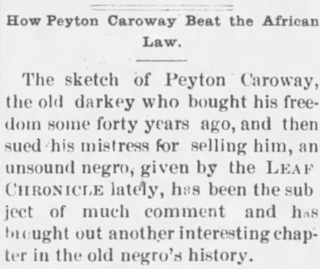
20 Jul Peyton Caraway: A story of a leader
By David Britton, Graduate student at Middle Tennessee State University and intern with History Before Us.
Like most histories of formerly enslaved people, Peyton Caraway’s early years are clouded by missing records and conflicting traditions. Put more simply – Black stories and genealogies are not usually found in a quick visit to the local archives. Such are the effects of chattel slavery and systemic racism in the U.S. However, the voice and legacy of Peyton Caraway persists. Let us hear what he has to say.
In one version of Peyton’s early years, he was given as a gift to a young girl named Doratha by her father at birth. Of course, such “gifts” are not unheard of or even rare. However, the record shows that the story is a bit more complicated. Sometime in the late 1820s, Doratha married Isaac Dennison and moved to Montgomery County, TN. The Dennison’s enslaved several men, women, and children over the course of their marriage. The 1830 Federal Census shows that five people were enslaved by the Dennisons. However, during the previous three years they had enslaved seven people: Solomon, Julia and her one-year old child, Louisa, and Dicy and her two children, Parthenia and Mary, who were six and ten years old when purchased. Peyton would have been around twenty years old during this census, but the slave schedule only lists one male between the ages of thirty-six and fifty-four. Thus, he had not been purchased yet. The 1840 Federal Census shows nine people enslaved by the Dennison’s. Unfortunately, no names for these enslaved are known. It is not known if Peyton is among the nine listed as Slave Schedules only indicate the sex and age. Either way, it is quite possible Peyton was purchased by this time.
Isaac died in 1841 and left his entire estate to Doratha. In 1850 Doratha remarried to Joseph Chilton. Joseph was already wealthy by most any measure, so when the two married their fortune was considerable – again, mostly by the enslavement of African American people. Joseph owned the large Franklin House hotel in downtown Clarksville, so it is likely that many of these enslaved people worked in it. At the time of their marriage, the Chilton’s enslaved sixteen people. Their ages ranged from four to 100 years old.
In 1853 is where we catch our first glimpse of Peyton in the record – and it proved to be a momentous year for him. On April 27th, Peyton entered into a contract with Joseph and Doratha to allow Peyton to purchase his freedom and be emancipated. Peyton relied upon a lawyer, J.G. Hornberger, as representation in court. The terms of the contract were $1000 plus anything he earned from being hired until he paid the total fee. Peyton was a Plasterer by trade and was frequently hired out. He kept a small salary from each job and had saved up the entire purchase price. But as is the usual, reality proved far more difficult.
Although the records are scant, several roadblocks appeared before Peyton. Even after he made his payment of $1000, the Chilton’s did not immediately honor the contract. Complicating Peyton’s endeavor further was that Tennessee State Law required all emancipated slaves to leave the State and go to Liberia in Africa. Eventually, he took the matter to court. The case was first heard in the smaller County Court and by 1856 the case was transferred to the Montgomery County Chancery Court.
The summary of this case is remarkably detailed and provides fantastic insight. While it does not specify why the Chilton’s were contesting Peyton’s manumission, the implication is that Joseph was against it. Peyton also secured the testimony of three wealthy white lawyers to prove that due to “age and disease”, he was unable to make the voyage to Liberia. After extensive proceedings, the court ruled in Peyton’s favor on all counts: Peyton was to be manumitted and made free and he was permitted to remain in the State of Tennessee as a free person of color. Joseph Chilton was ordered to make a $2,000 bond to the county trustee to secure Peyton’s freedom. So, on April 28, 1856 Peyton Caraway became a free man. A version of this story appeared in an 1891 article in the local newspaper and claimed that Peyton had sued his enslaver after his manumission. He claimed that due to his physical infirmity, he was unable to work very hard. Thus, his former enslaver had sold Peyton “a bad negro”, meaning himself. According to that story, Peyton won the case.
The records lose track of Peyton during the war years, but it’s clear that he was a man on a mission. In 1870, Peyton and two other men as the trustees of the “Colored Citizens of New Providence” purchased a small lot of land to be a new cemetery for the African American community. It is possible this cemetery began its life as an internment for contrabands during the years of war, especially considering its proximity to the Federal Army fortification. This cemetery was eventually known as the Green Hill Church cemetery. Today, it sits abandoned and overgrown.

In 1872, Peyton was elected as a Montgomery County delegate to the State Radical party convention. The Radicals, or Radical Republicans, were a political faction that supported the immediate abolishment of slavery before and during the war. They supported the election of U.S. Grant in 1868 and his reelection in 1872 and dissolved soon after. Peyton was one of four African American men elected to the State convention that year. Further, Peyton appears to have continued plastering and acquired three acres and owned his house in New Providence that remained in his family for three generations.
In 1891, the local newspaper printed an article about Peyton. While the tone of the article is generally condescending and intended to make a spectacle of him, it inadvertently tells us quite a bit about him. By this time in his life, he was making and selling a variety of homeopathic remedies: snakeroot, rattlesnake weed, slippery elm, sassafras, Indian turnip, spice-wood, walnut bark, among others. The article further states that Peyton was known as a “conjurer” to the African American community for miles around. Peyton’s reliance on the stars and what the article refers to as “nostrums and yarbs”, of course, paints Peyton as a “quack doctor”. However, the article finishes with: “Such a hold he has on the people of his race in that locality, that they all regard him with awe.” If read between the lines, this article shows us that Peyton was connecting with traditions and culture with deep roots in west Africa and possibly southeastern Indigenous America. For the African American community, Peyton was no quack – he was viewed as an elder who possessed tremendous wisdom. Materially, he demonstrated his care for the community in a time when it needed the leadership he provided.
Peyton was recorded as a male voter in 1891 and later when he was listed as a parent on one of his adult children’s death certificates. These are the last recorded mentions of his name. His grave is unrecorded and unmarked, though it is hoped his grave may be found in the abandoned New Providence cemetery. Peyton and his wife Agness, who was also enslaved, had four children and numerous grandchildren and great-grandchildren. It should be noted that in each following generation of the Caraway family, there has been a teacher or community leader. His most recently deceased descendent held multiple master’s degrees, whose life was devoted to teaching in a number of middle Tennessee schools.
Peyton’s life demonstrates the importance of legacy. It’s never too late to be the paradigm shift in your own family. The impact of your decisions can be felt for generations to come. But the record of Peyton’s life is also systemic racism on display. Peyton, Agness, and most of their children lay in unmarked graves, in an abandoned cemetery in an African American community greatly affected by poverty. Peyton’s story is heroic, yet untold. The only story written about him until now treated him as amusement or a spectacle. Yet, Peyton’s voice has spoken from beyond the grave and tells us “I am only one of thousands. Time to help all of us speak.”
Cemetery pics: David Britton
Newspaper clipping: The Leaf Chronicle, 4/10/1891



No Comments